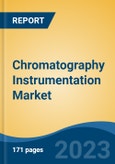Speak directly to the analyst to clarify any post sales queries you may have.
10% Free customizationThis report comes with 10% free customization, enabling you to add data that meets your specific business needs.
Market growth has remained steady, fueled by increasing adoption across pharmaceuticals, biotechnology, petrochemicals, and food safety testing. The rising complexity of analytical methodologies, coupled with stringent regulatory standards, has intensified the need for highly accurate and reliable chromatography systems. However, the high capital investment required for advanced chromatography instruments remains a barrier, particularly for small and medium-sized enterprises (SMEs) and academic institutions, which often face budget constraints.
Key Market Drivers
Growth in Food Safety and Quality Testing
The increasing emphasis on food safety and quality assurance has significantly fueled the demand for chromatography instrumentation worldwide. Globally, 600 million people suffer from foodborne illnesses each year due to contaminated food, resulting in 420,000 fatalities annually. To mitigate these risks, food industry stakeholders are mandated to implement comprehensive food safety management systems. As food supply chains become more complex and globalized, the need for precise, efficient, and regulatory-compliant analytical techniques has intensified.Chromatography plays a crucial role in detecting contaminants, ensuring product consistency, and meeting stringent safety standards, thereby driving its adoption across the food and beverage industry. Governments and regulatory bodies worldwide have imposed strict guidelines to ensure food safety and prevent public health risks. Organizations such as: U.S.
Food and Drug Administration (FDA), European Food Safety Authority (EFSA), Food Safety and Standards Authority of India (FSSAI), World Health Organization (WHO) mandate rigorous testing of food products for contaminants, additives, and nutritional content. Compliance with these regulations requires highly accurate and reliable analytical techniques, where liquid chromatography (LC), gas chromatography (GC), and mass spectrometry (MS) serve as primary tools. Failure to comply with these regulations can result in product recalls, legal penalties, and reputational damage, pushing food manufacturers to invest in advanced chromatography instruments to ensure compliance and quality control.
Key Market Challenges
High Initial Costs
One of the primary challenges hindering the growth of the Chromatography Instrumentation Market is the high initial costs associated with purchasing chromatography instruments. These instruments, such as high-performance liquid chromatography (HPLC) systems or gas chromatography-mass spectrometry (GC-MS) systems, can be expensive to acquire. The substantial upfront investment required can deter smaller research laboratories, academic institutions, and emerging markets from adopting chromatography techniques. This challenge can limit the accessibility of chromatography instrumentation, especially in resource-constrained environments. It may slow down market growth by restricting the potential user base and market penetration.Key Market Trends
Technological Advancements
Technological advancements represent a prominent trend in the Chromatography Instrumentation Market. Manufacturers and researchers are continually innovating to improve the performance, efficiency, and versatility of chromatography instruments. Some key technological trends include:The development of smaller, more compact chromatography instruments allows for greater portability and saves laboratory space. Miniaturization also reduces solvent and sample consumption. Automation is on the rise in chromatography instrumentation. Automated sample preparation, injection, and data analysis streamline workflows, reduce human error, and increase throughput. High-resolution chromatography instruments, such as ultra-high-performance liquid chromatography (UHPLC) and high-resolution mass spectrometry (HRMS), offer superior separation and detection capabilities, enabling the analysis of complex samples with unprecedented precision. Combining chromatography with other analytical techniques like mass spectrometry (LC-MS and GC-MS) and nuclear magnetic resonance (NMR) enhances the depth of analysis and opens new avenues for research.
These technological advancements are driving market growth by making chromatography more powerful, efficient, and accessible to a broader range of applications and industries.
Key Market Players
- Agilent Technologies Inc
- Waters Corporation
- Shimadzu Corporation
- Thermo Fisher Scientific
- Perkinelmer, Inc.
- Merck KGaA
- Sartorius AG
- Bio-Rad Laboratories
- Restek Corporation
- Gilson, Inc.
Report Scope:
In this report, the Global Chromatography Instrumentation Market has been segmented into the following categories, in addition to the industry trends which have also been detailed below:Chromatography Instrumentation Market, By Device:
- Chromatography Systems
- Consumables
- Accessories
Chromatography Instrumentation Market, By Application:
- Agriculture
- Pharmaceutical Firms
- Clinical Research Organizations
- Environmental Testing
Chromatography Instrumentation Market, By Region:
- North America
- United States
- Canada
- Mexico
- Europe
- France
- United Kingdom
- Italy
- Germany
- Spain
- Asia-Pacific
- China
- India
- Japan
- Australia
- South Korea
- South America
- Brazil
- Argentina
- Colombia
- Middle East & Africa
- South Africa
- Saudi Arabia
- UAE
Competitive Landscape
Company Profiles: Detailed analysis of the major companies present in the Global Chromatography Instrumentation Market.Available Customizations:
With the given market data, the publisher offers customizations according to a company's specific needs. The following customization options are available for the report.Company Information
- Detailed analysis and profiling of additional market players (up to five).
This product will be delivered within 1-3 business days.
Table of Contents
Companies Mentioned
- Agilent Technologies Inc
- Waters Corporation
- Shimadzu Corporation
- Thermo Fisher Scientific
- Perkinelmer, Inc.
- Merck KGaA
- Sartorius AG
- Bio-Rad Laboratories
- Restek Corporation
- Gilson, Inc.
Table Information
| Report Attribute | Details |
|---|---|
| No. of Pages | 180 |
| Published | March 2025 |
| Forecast Period | 2024 - 2030 |
| Estimated Market Value ( USD | $ 10.7 Billion |
| Forecasted Market Value ( USD | $ 14.5 Billion |
| Compound Annual Growth Rate | 5.1% |
| Regions Covered | Global |
| No. of Companies Mentioned | 10 |









